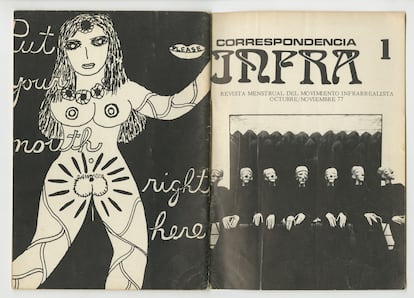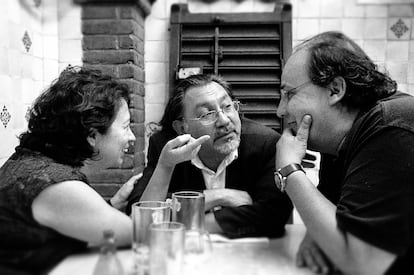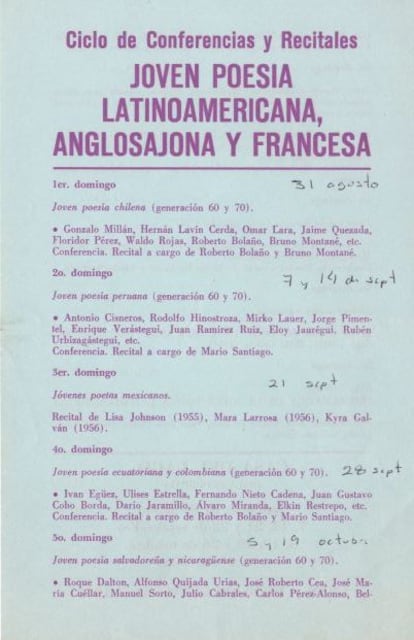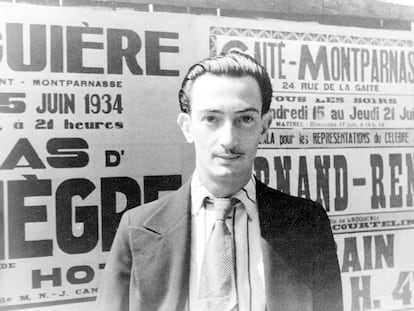What the ‘Infrarealists’ from Bolaño’s ‘The Savage Detectives’ are doing now
In his acclaimed novel, Chilean writer Roberto Bolaño immortalized Mexico City’s 1970s poet counterculture, turning his fellow rebel-writers into icons and objects of criticism. EL PAÍS spoke with the movement’s living members, now in their 60s, to see what they’re up to today

They were writers, and most were younger than 20. They wanted — in the words of the Chilean painter Roberto Matta who gave them their motto — to “blow the brains out of the cultural establishment.” They were fast, smart, young — practically teenagers — and they moved through Mexico City in the 1970s with a turbulence to match the times, writing for the cultural supplements of local newspapers, struggling to scrape together enough pesos to buy coffee and a few hours of conversation at Café La Habana. But above all, they were poets: they thought, breathed, and lived poetry; they believed in it as if it were a weapon, loaded with the future. Their entire beings were oriented in opposition to the establishment, to Octavio Paz and any other authors who basked in the comfort of their institutions. They were the counterculture to the counterculture. They were punk before there was punk. They found new ways of writing about politics, about love, about sex and death. They called themselves Infrarealists, and for decades found themselves marginalized from the circles of cultural and artistic influence, forgotten by critics and rejected by publishers. Until many years later, one of them, a Chilean writer who had fled the dictatorship of Augusto Pinochet and ended up in Mexico, and then later Barcelona, immortalized their milieu in a book that many critics would call the last great Latin American novel. That writer’s name was Roberto Bolaño, and the book: The Savage Detectives.
Bolaño turned the adventures of his fellow poets into the stuff of legend, elevating the movement to the realm of myths. Using pseudonyms, Bolaño fictionalized his fellow Infrarealists as the protagonists of his now famous novel, a book — part polyphonic narrative, part detective story, part existential poetry — that won the prestigious Herralde Prize. Following its publication in 1998 (an English translation by Natasha Wimmer was published in 2007), rivers of ink would pour across the pages of academic and cultural publications — dissertations, essays, articles and all manner of criticism — and the work would go on to influence future generations of “savage poets,” in Mexico and beyond. But the book was also a curse. Bolaño drew from real sources and wrote about real people and real events, and though ultimately the novel was fiction, it constantly blurred the line between literary fabrication and historical fact. The real Infrarealists, then, were condemned to assert themselves as real people and real writers, against their now famous portrayals as characters in a book. Many were annoyed or even enraged by Bolaño’s novel, though most eventually made peace with their nonconsensual characterizations.

Infrarealism was born in 1975, conceived between heated late-night conversations about poetry and cups of café con leche La Habana Café in Mexico City. Bolaño and fellow poet Mario Santiago Papasquiaro (born José Alfredo Zendejas) were the movement’s most visible faces, and its main drivers. Almost the entire weight of The Savage Detectives is built from the fictionalized accounts of their travels and misadventures — with Bolaño as “Arturo Belano” and Mario Santiago as “Ulises Lima.” Bolaño pronounced Infrarealism dead in 1977 when he left Mexico for Europe. But the rest of the movement’s poets, guided by Mario Santiago, kept it alive.
Nearly 50 years later, 64-year-old Guadalupe Ochoa — “Xóchitl García” in The Savage Detectives — sits at a café in the historic Mexico City borough of Coyoacán, smoking unfiltered cigarettes. Life has taken her in a different direction — she’s a teacher and a documentary filmmaker — but she never stopped writing poetry. “For me, being Infra is like learning how to walk,” she says. “It’s a way of being in the world, and this can have good and bad implications.” Among other projects, Ochoa is currently working on a novel about those early years — a response, in a sense, to Bolaño. One of the Chilean author’s greatest liabilities, in the eyes of some fellow Infrarealists and others, was his treatment of women in The Savage Detectives, which many have criticized as sexist.

Ochoa acknowledges the macho dynamics that characterized the movement at the time: “A lot of the guys were a lot more respectful than most other men of my generation — they were kind and generous, and talented. But that doesn’t excuse the fact that a lot of them were also really abusive, prone to beating people — and not just women.” This, Ochoa says, is why she distanced herself over the years from some of the group’s original members, as did another of the movement’s founders, Mara Larrosa. But Ochoas’s life with the Infrarealists was always defined by contradiction: her love for the poets with whom she had discovered the world, against a reality too uncomfortable to be ignored.
When she was still quite young, Ochoa married fellow Infra poet José Peguero — “Jacinto Requena” in Bolaño’s novel — and together they had a son. Peguero is now 67. He met Bolaño and Mario Santiago when he was 19, at a poetry workshop at Casa del Lago, an off-campus cultural center of the National Autonomous University of Mexico (UNAM), and has stayed committed to the movement ever since. Now, Peguero works in film and says he writes less and less each year, but insists he’s still an Infrarealist. “The important thing was always how you saw poetry,” says Peguero, speaking with EL PAÍS on a July afternoon in Mexico City’s famous film museum, the Cineteca Nacional. “The perspectives of Infrarealism are still valid. Infrarealism is a way of being, of absorbing life, pleasure, poetry. For me, the movement is still very alive, but the popular perception is that we’re all dead. But it was never about institutional recognition, and we’re still keeping that sort of belligerent attitude alive.”
The Infrarealist diaspora
One of the slogans from the movement’s first manifesto, inspired by a line from French surrealist André Breton, was “¡Déjenlo todo, nuevamente!” — “Abandon everything, again!” Many of the group’s members, including Bolaño and Papasquiaro, took the imperative literally and eventually left the movement, scattering across Europe and elsewhere in diaspora. One of the group’s founders and a fellow Chilean exile, Bruno Montané Krebs — “Felipe Müller” in the novel — left Mexico in 1976 for Barcelona, and Bolaño soon followed after.
Montané, who a few years ago, in 2018, published a collection of poems titled El futuro (“The Future”), is Infrarealism’s contemporary custodian. A decade ago, he cofounded — with Ana María Chagra — the publishing house Ediciones Sin Fin, named after “Sueño sin fin” (“Dream with no end”), a poem by Mario Santiago and the title of the publisher’s first book. Montané's publishing house now offers the most extensive catalogue of Infrarealist titles in the world. When he arrived in Barcelona, Montané was 19 years old and worked as a painter, or found gigs playing saxophone in local “Pachanga bands,” he recounts between laughs, sitting at a coffee shop in Barcelona’s El Ravál neighborhood, near the Céntric (a restaurant featured in The Savage Detectives). At 65, Montané says he still has a hard time making enough money, and works as a proofreader to get by. He lives in the same El Ravál apartment he moved into when he came to the city in the mid-seventies. “If it weren’t for the fact that it’s an old rental, I wouldn’t be able to afford it,” he says.

Years ago, the streets here in Ciutat Vella — Barcelona’s “Old City” district — witnessed Bolaño and Montané's friendship bloom. The poets would collaborated on literary zines (still unpublished), and would often share books with each other, like the atlas that Montané's father compiled on the Sonoran Desert, which Bolaño (“who had never been there”) would later use to write the final part of The Savage Detectives and his posthumously published magnum opus, 2666. Despite “moments of estrangement,” their relationship never faded, Montané says. “After he died [in 2003], Roberto would appear in my dreams. He was alive: he had joined an underground of secret authors. That’s how my unconscious worked. It was my way of bringing back my first friend, from a time when we were nobodies, from a time when the only thing we did was write.”
In 1978, Rubén Medina — “Rafael Barrios” in The Savage Detectives — left for California in pursuit of love. For a while, he made a living working different low-paying jobs. Today, he’s a professor of literature at the University of Wisconsin. “Bolaño gave visibility to a movement that was very, very marginal,” Medina told EL PAÍS during a brief visit to Mexico City, the sounds of traffic from Insurgentes Ave. pouring through the hotel window. “The unfortunate thing is that now people only view that reality through him, through the legend, the myth, the figure of Ulises Lima, life in Mexico City in the late 70s, the Infrarealists at Café La Habana — all that stuff, it’s become almost like a mythology.” When The Savage Detectives was published, Medina was angry with Bolaño for some time, avoiding interviews so he wouldn’t have to answer questions about him or the book. But eventually, Medina came to embrace that part of the legacy as well, writing about Infrarealism for Chicago Review and publishing a book of Infrarealist poems and criticism titled Perros habitados por las voces del desierto (2014).

When Jorge Hernández left Mexico in 1982, he carried the nickname that the Infrarealist “gang” had branded him with like a destiny. They called him Piel Divina (Divine Skin) for his “smooth, shiny skin, totally hairless, like the skin of a snake.” The nickname had an air of transcendence. Even more so when Bolaño gave the name to one of his characters in The Savage Detectives. Hernández, speaking with EL PAÍS over video call from his home in the forest near Paris, says the nickname “preceded” him: “I had to go searching for him, like I was chasing my own shadow.” His quest to find Piel Divina took him to the other side of the Atlantic.
—What inspired you to leave?
—Love, my friend. Love.
Hernández met his partner at a surrealist “protest” in France, and together they moved to Paris. For the first few years, Piel Divina worked as a painter. But eventually, his artistic interests turned toward the “hand-to-hand combat” of sculpture. “It’s like trying to set traps for light,” he says as he presents one of his pieces, a wooden form made from the bark of the trees that surround his home, perforated, he says, to reflect the meaning that comes out of emptiness.
Years later, Piel Divina had a “chance encounter” with Bolaño while strolling along the banks of the Seine. “He was in his own world, as usual, with papers and books jammed into his pockets,” Hernández recalls. “It was a brief meeting, neither of us had any money, we could barely afford to buy a cup of coffee.” Hernández had a second chance to catch up with Bolaño when the Chilean was visiting Paris on a book tour for one of his novels. Piel Divina didn’t attend the reading.
Seated in the audience that day, however, was José Rosas Ribeyro, a Peruvian writer expelled to Mexico in 1975 by the dictatorship of Juan Velasco Alvarado. Rosas Ribeyro was living in Paris when his friend, the artist Margarita Caballero, noticed a flyer advertising a weekly series of readings by Latin American poets, organized by none other than Roberto Bolaño and Mario Santiago. Sitting at a ramen restaurant in downtown Barcelona, where he’s lived since 2017, Rosas Ribeyro throws up his arms as he recalls the shock of hearing one of his own poems read aloud as he sat in the audience. “Thank you for reading one of my poems,” he remembers saying after the reading. “And who are you?” the shaggy-haired poets asked him. “I’m Rosas Ribeyro,” he responded. “Brother!” they shouted, and leapt up to give Ribeyro a hug. From then on, he was part of the Infrarealist brotherhood. Mario Santiago always said that Piel Divina was one of his poetic role models.
Another Chilean, Juan Esteban Harrington — the protagonist “Juan García Madero” in the first part of the The Savage Detectives — also ended up in Barcelona, following in the footsteps of Bolaño and Montané. Harrington, one of the youngest Infrarealists, was only 15 when the movement formed. He would live three years in Europe before returning home to the Americas. Harrington still writes poetry, but focuses mostly on filmmaking. “When we read The Savage Detectives, we saw each and every one of us,” he says. “It’s all fictionalized and exaggerated, but they’re anecdotes of things that really happened.” When the novel was first published, Harrington felt betrayed, but eventually he made peace with his old friend. “For me, the Infras and my move to Europe are the most important parts of my life. They’re what made me who I am today.”
The legacy of Infrarealism extends far beyond the works of Bolaño. Ediciones Sin Fin and Rubén Medina have done a remarkable job compiling the movement’s unpublished works, collecting a vast body of writing that had been scattered across time, and across the hidden corners of the literary underground. The Infrarealist review La zorra vuelve al gallinero continues to publish new issues on a sporadic basis, and the movement did not end with Bolaño’s death, nor with the death of Papasquiaro in 1998, nor of Darío Galicia, nor of Ramón and Cuauhtémoc Méndez – Ernesto San Epifanio and Pancho and Moctezuma Rodríguez in The Savage Detectives, respectively. The movement’s living members, who continue to blow the brains out of the establishment well into their 60s, are an enduring testament to the movement’s survival: Savage detectives – half myth, half reality – hiding among the pages of literature and in the memories of history.

Tu suscripción se está usando en otro dispositivo
¿Quieres añadir otro usuario a tu suscripción?
Si continúas leyendo en este dispositivo, no se podrá leer en el otro.
FlechaTu suscripción se está usando en otro dispositivo y solo puedes acceder a EL PAÍS desde un dispositivo a la vez.
Si quieres compartir tu cuenta, cambia tu suscripción a la modalidad Premium, así podrás añadir otro usuario. Cada uno accederá con su propia cuenta de email, lo que os permitirá personalizar vuestra experiencia en EL PAÍS.
¿Tienes una suscripción de empresa? Accede aquí para contratar más cuentas.
En el caso de no saber quién está usando tu cuenta, te recomendamos cambiar tu contraseña aquí.
Si decides continuar compartiendo tu cuenta, este mensaje se mostrará en tu dispositivo y en el de la otra persona que está usando tu cuenta de forma indefinida, afectando a tu experiencia de lectura. Puedes consultar aquí los términos y condiciones de la suscripción digital.
More information
Últimas noticias
Most viewed
- Reinhard Genzel, Nobel laureate in physics: ‘One-minute videos will never give you the truth’
- Oona Chaplin: ‘I told James Cameron that I was living in a treehouse and starting a permaculture project with a friend’
- Pablo Escobar’s hippos: A serious environmental problem, 40 years on
- Why we lost the habit of sleeping in two segments and how that changed our sense of time
- Charles Dubouloz, mountaineering star, retires at 36 with a farewell tour inspired by Walter Bonatti










































